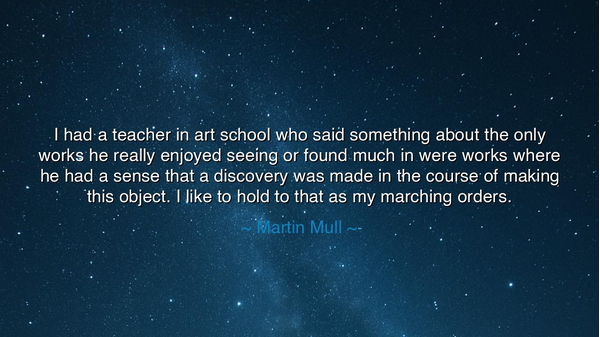
I had a teacher in art school who said something about the only
I had a teacher in art school who said something about the only works he really enjoyed seeing or found much in were works where he had a sense that a discovery was made in the course of making this object. I like to hold to that as my marching orders.






In the words of Martin Mull, we hear a profound truth about the nature of art, creation, and the spirit of discovery. He recalls a teacher who declared that the most valuable works are those in which one can sense that the artist made a discovery in the very act of creating. Mull takes this wisdom as his marching orders, making it the compass by which he navigates his craft. These words remind us that true creation is not a matter of repetition or formula, but of exploration, risk, and revelation.
The meaning of this teaching is clear: the greatest art is born not from certainty, but from the willingness to step into the unknown. A painting, a poem, a song—these become alive not when they simply mirror skill, but when they carry the trace of a journey taken by the creator. Just as explorers carved new paths across mountains and seas, so too must the artist wander through the wilderness of imagination, stumbling upon insights that even they did not foresee. This element of surprise, of discovery, breathes life into the work and makes it worthy of remembrance.
History offers us shining examples. Consider the story of Jackson Pollock, whose drip paintings at first seemed chaotic and unplanned. Yet within the act of flinging paint, Pollock discovered new rhythms of movement, new dialogues between chance and intention. Each canvas was not a predetermined design, but an unfolding revelation. The world saw in his work not only paint, but the record of a man discovering a new language of art. In this way, his journey mirrored the ancient truth Mull describes: creation becomes meaningful when discovery accompanies it.
The ancients, too, knew this wisdom. The sculptor Michelangelo once said that he did not carve statues, but released them from the marble where they already resided. In every blow of his chisel, there was a discovery, a moment of unveiling what lay hidden within the stone. Had he approached his work as mere repetition of craft, the figures would be lifeless. But because his work was a dialogue with the unknown, the results became timeless. Such is the essence of true artistry: to enter the work as one enters a mystery, and to leave it transformed.
For those who create, Mull’s quote is a reminder to resist the comfort of certainty. To serve discovery in your work is to allow yourself to be surprised by what emerges. This applies not only to artists, but to all walks of life. The teacher who learns from their students, the scientist whose experiment reveals the unexpected, the writer whose character takes on a life of its own—all are part of this great rhythm of discovery. To live this way is to embrace creation not as a product, but as a journey of becoming.
The lesson for us all is that true value lies not in perfect execution, but in the courage to explore. If you paint, let the brush surprise you. If you write, let your words wander. If you labor, allow your hands to reveal truths that the mind did not yet conceive. For the greatest works are those that carry within them the story of how their maker was changed in the act of making. Without this, even the most polished creation is but an empty shell.
Practically, we must adopt Mull’s marching orders in our own lives: enter your tasks with openness, seek the spark of the unknown, and welcome the lessons that arise unexpectedly. Let every endeavor be an opportunity to discover—not only the world, but also yourself. For in discovery lies growth, in growth lies meaning, and in meaning lies the enduring beauty that touches others across time.
Thus, remember this wisdom: the finest creations are not those made with certainty, but those shaped by the dance of discovery. To create is to journey, and to journey is to find what you did not yet know you carried within. Serve this truth faithfully, and your works—whether great or small—will live as testimonies of the eternal bond between creation and discovery.






AAdministratorAdministrator
Welcome, honored guests. Please leave a comment, we will respond soon